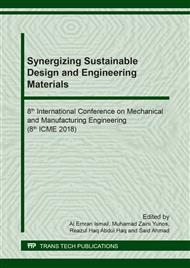[1]
R. Dweiri, J. Sahari, Electrical properties of carbon-based polypropylene composites for bipolar plates in polymer electrolyte membrane fuel cell (PEMFC), J. Power Sources. 171 (2007) 2: 424–432.
DOI: 10.1016/j.jpowsour.2007.05.106
Google Scholar
[2]
N. F. Asri, Interfacial Contact Resistance for Ti-6Al-4V and SUS 316L Plates as Bipolar Plates in PEMFC Fuel Cell Engineering , Institute of Fuel Cell , National University of Malaysia , Department of Power Electronics and Drive , Faculty of Electrical Engineering. 24 (2016) 4: 1436–1442.
Google Scholar
[3]
M. Y. Zakaria, A. B. Sulong, J. Sahari, H. Suherman, Effect of the addition of milled carbon fiber as a secondary filler on the electrical conductivity of graphite/epoxy composites for electrical conductive material, Compos. Part B Eng. (2015) 83: 75–80.
DOI: 10.1016/j.compositesb.2015.08.034
Google Scholar
[4]
B. K. Kakati, D. Sathiyamoorthy, and A. Verma, Semi-empirical modeling of electrical conductivity for composite bipolar plate with multiple reinforcements, Int. J. Hydrogen Energy. 36 (2011) 22: 14851–14857.
DOI: 10.1016/j.ijhydene.2011.02.136
Google Scholar
[5]
T. Alomayri, F. U. A. Shaikh, I. M. Low, Effect of fabric orientation on mechanical properties of cotton fabric reinforced geopolymer composites, Mater. Des. 57 (2014) 0: 360–365.
DOI: 10.1016/j.matdes.2014.01.036
Google Scholar
[6]
R. Dweiri, J. Sahari, Microstructural image analysis and structure–electrical conductivity relationship of single- and multiple-filler conductive composites, Compos. Sci. Technol. 68 (2008) 7–8: 1679–1687.
DOI: 10.1016/j.compscitech.2010.04.001
Google Scholar
[7]
N. Hu, Z. Masuda, G. Yamamoto, H. Fukunaga, T. Hashida, J. Qiu, Effect of fabrication process on electrical properties of polymer/multi-wall carbon nanotube nanocomposites, Compos. Part A Appl. Sci. Manuf. 39 (2008) 5: 893–903.
DOI: 10.1016/j.compositesa.2008.01.002
Google Scholar
[8]
Y. Nakayama, E. Takeda, T. Shigeishi, H. Tomiyama, T. Kajiwara, Melt-mixing by novel pitched-tip kneading disks in a co-rotating twin-screw extruder, Chem. Eng. Sci. 66 (2011) 1: 103–110.
DOI: 10.1016/j.ces.2010.10.022
Google Scholar
[9]
R. Taherian, M. J. Hadianfard, A. N. Golikand, Manufacture of a polymer-based carbon nanocomposite as bipolar plate of proton exchange membrane fuel cells, Mater. Des. 49 (2013) 0: 242–251.
DOI: 10.1016/j.matdes.2013.01.058
Google Scholar
[10]
A. Adloo, M. Sadeghi, M. Masoomi, H. N. Pazhooh, High performance polymeric bipolar plate based on polypropylene/graphite/graphene/nano-carbon black composites for PEM fuel cells, Renew. Energy. (2016) 99: 867–874.
DOI: 10.1016/j.renene.2016.07.062
Google Scholar
[11]
R. L. Barton, J. M. Keith, J. A. King, Electrical conductivity model evaluation of carbon fiber filled liquid crystal polymer composites, J. Appl. Polym. Sci. 106 (2007) 4: 2456–2462.
DOI: 10.1002/app.26877
Google Scholar
[12]
R. A. Antunes, M. C. L. de Oliveira, G. Ett, V. Ett, Carbon materials in composite bipolar plates for polymer electrolyte membrane fuel cells: A review of the main challenges to improve electrical performance, J. Power Sources. 196 (2011) 6: 2945–2961.
DOI: 10.1016/j.jpowsour.2010.12.041
Google Scholar
[13]
H. Suherman, J. Sahari, A. B. Sulong, Effect of small-sized conductive filler on the properties of an epoxy composite for a bipolar plate in a PEMFC, Ceram. Int. 39 (2013 6: 7159–7166.
DOI: 10.1016/j.ceramint.2013.02.059
Google Scholar
[14]
N. A. Mohd Radzuan, A. B. Sulong, J. Sahari, A review of electrical conductivity models for conductive polymer composite, Int. J. Hydrogen Energy. 42 (2017) 14: 9262–9273.
DOI: 10.1016/j.ijhydene.2016.03.045
Google Scholar
[15]
J. M. Keith, J. A. King, R. L. Barton, Electrical conductivity modeling of carbon-filled liquid-crystalline polymer composites, J. Appl. Polym. Sci. 102 (2016) 4: 3293–3300.
DOI: 10.1002/app.24748
Google Scholar
[16]
R. Taherian, M. J. Hadianfard, A. N. Golikand, A new equation for predicting electrical conductivity of carbon-filled polymer composites used for bipolar plates of fuel cells, J. Appl. Polym. Sci. 128 (2013) 3:1497–1509.
DOI: 10.1002/app.38295
Google Scholar
[17]
A. Kono, Positive-temperature-coefficient effect of electrical resistivity below melting point of poly(vinylidene fluoride) (PVDF) in Ni particle-dispersed PVDF composites," Polymer (Guildf). 53 (2012) 8: 1760–1764.
DOI: 10.1016/j.polymer.2012.02.048
Google Scholar
[18]
A. Mejía, N. García, J. Guzmán, P. Tiemblo, Extrusion Processed Polymer Electrolytes based on Poly(ethylene oxide) and Modified Sepiolite Nanofibers: Effect of Composition and Filler Nature on Rheology and Conductivity, Electrochim. Acta. 137 (2014) 526–534.
DOI: 10.1016/j.electacta.2014.06.032
Google Scholar
[19]
J. Wang, Shear induced fiber orientation, fiber breakage and matrix molecular orientation in long glass fiber reinforced polypropylene composites, Mater. Sci. Eng. A. 528 (2011) 7–8: 3169–3176.
DOI: 10.1016/j.msea.2010.12.081
Google Scholar
[20]
G. A. Jimenez, S. C. Jana, Electrically conductive polymer nanocomposites of polymethylmethacrylate and carbon nanofibers prepared by chaotic mixing, Compos. Part A Appl. Sci. Manuf. 38 (2007) 3: 983–993.
DOI: 10.1016/j.compositesa.2006.06.017
Google Scholar
[21]
Z. Fan, S. G. Advani, Characterization of orientation state of carbon nanotubes in shear flow, Polymer (Guildf). 46 (2005)14: 5232–5240.
DOI: 10.1016/j.polymer.2005.04.008
Google Scholar
[22]
P. Pötschke, A. R. Bhattacharyya, A. Janke, Melt mixing of polycarbonate with multiwalled carbon nanotubes: microscopic studies on the state of dispersion, Eur. Polym. J. 40 (2004) 1:137–148.
DOI: 10.1016/j.eurpolymj.2003.08.008
Google Scholar
[23]
T. Köpplmayr, Influence of fiber orientation and length distribution on the rheological characterization of glass-fiber-filled polypropylene, Polym. Test. 32 (2013) 3: 535–544.
DOI: 10.1016/j.polymertesting.2013.02.002
Google Scholar
[24]
R. Taipalus, T. Harmia, M. Q. Zhang, K. Friedrich, The electrical conductivity of carbon-fibre-reinforced polypropylene/polyaniline complex-blends: experimental characterisation and modelling, Compos. Sci. Technol. 61(2001) 6: 801–814.
DOI: 10.1016/s0266-3538(00)00183-4
Google Scholar
[25]
M. Sharma, I. M. Rao, J. Bijwe, Influence of orientation of long fibers in carbon fiber–polyetherimide composites on mechanical and tribological properties, Wear. 267(2009) 5–8: 839–845.
DOI: 10.1016/j.wear.2009.01.015
Google Scholar
[26]
S. Tungjitpornkull, N. Sombatsompop, Processing technique and fiber orientation angle affecting the mechanical properties of E-glass fiber reinforced wood/PVC composites, J. Mater. Process. Technol. 209 (2009) 6:3079–3088.
DOI: 10.1016/j.jmatprotec.2008.07.021
Google Scholar
[27]
N. A. Mohd Radzuan, A. B. A. B. Sulong, M. Rao Somalu, Optimization of Milled Carbon Fibre Extrusion and Polypropylene Process for Conductive Polymer Composite, Sains Malaysiana. 45(2016) 1913–(1921).
DOI: 10.17576/jsm-2016-4512-16
Google Scholar


